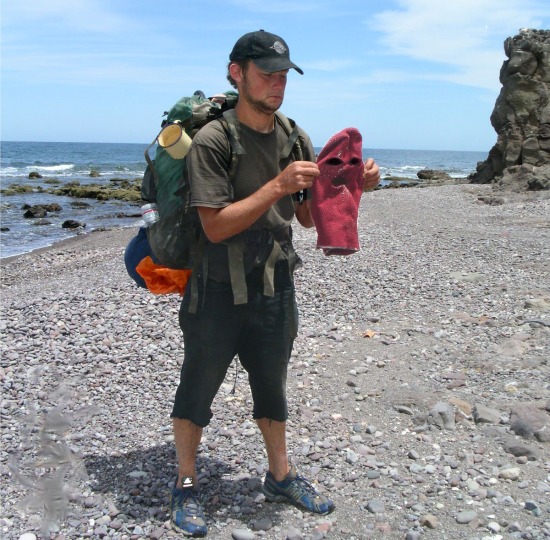The Wonders that Wash Ashore: Malarrimo Beach
The attraction of beachcombing is that one isn’t perusing a garbage dump; much of what one sifts through on a stretch of sand are valuables lost at sea
/https://tf-cmsv2-smithsonianmag-media.s3.amazonaws.com/filer/20111122125013vehicle-malarrimo-beach-web.jpg)
People campaign against plastic and volunteer on beach cleanup days—but what would Malarrimo Beach in Baja California be without its wonderful array of worldly garbage?
Trash of nearly every water-insoluble sort comes ashore on this far-flung stretch of sand. It’s on the north-facing shore of a conspicuous “horn” about halfway down the Baja Peninsula on the Pacific Coast side. The land juts sharply westward into the waters of the California Current, which generates a rich upwelling along the coast but also carries riches of different sort: boat wreckage, clothing, first-aid kits, military gear, toys, preserved foods and so many other curios. The attraction of beachcombing is that one isn’t perusing an actual garbage dump; much of what one sifts through on a remote stretch of sand are valuables lost at sea. Huge logs of Northwest timber, for instance, come ashore at Malarrimo, and there are probably several classy Baja palapas built of California redwood. Lucky beachgoers may find currency notes here and bottles of liquor, too. Happily, the place is far from the main roads of Baja and is very inconvenient to reach. One must turn west at the desert town of Vizcaino, drive 70 miles and then take on the final stretch—26 miles of bumpy unpaved dirt.
Of course, Graham Mackintosh, with whom I spoke last week about his Baja travels, walked to Malarrimo during his circumpeninsular foot tour in the early 1980s. Approaching the beach from the north, Mackintosh had to improvise his way across the mouths of several huge lagoons on Baja’s Pacific Coast—the famed breeding grounds of the Eastern Pacific gray whale. He hitched boat rides with commercial lobstermen and on one muddy shore even found an abandoned skiff in which he made another crossing. Finally, Mackintosh stepped onto the legendary sands of Malarrimo Beach, “reputed,” as he wrote in his book Into a Desert Place, “to offer the finest beachcombing in the world.”
He goes on: “The scene was incredible. It was as if some terrible and destructive battle had taken place off the coast. The shore was littered with planks, buckets, tree trunks, helmets, hatch covers, bits and pieces of boats and planes, and all kinds of military and medical equipment.”
He found canisters of nerve gas antidote, a coconut, contraceptives “and some kind of missile with wires hanging from the back.”

Beachcombing in Baja turns up the unexpected as the author, shown in 2005, ponders the dark past of an ominous-looking ski mask. Photo by Milton Wong.
“I could have done with a supermarket trolley,” Mackintosh quips—for the preserved junk food was abundant. He added to his baggage cans of soda, milk and chocolate syrup. He found lifeboat rations. He found “biscuits from Spain.”
Almost anyone who has backpacked someplace hot and dry, where water must be carried in bottles and only lightweight foods can be packed for sustenance, has dreamed of finding a lost bottle of whiskey beside the trail—and some of Mackintosh’s finds were, quite literally, the stuff of daydreams. He swiped up cans of beer, a bottle of Bacardi, another of Martini, and some “very old, very excellent Japanese whiskey.” Over several days exploring, he found more and more liquor, including Scotch, brandy and London gin. He felt compelled to squirrel these all away in his backpack (who wouldn’t?) and even began to wish for an end to the ludicrously lucky bounty. He found a sizeable flask, too, in which—after conducting a proper tasting—he blended all the booze to optimize his backpack ballast.
He left the empty bottles for posterity.
Onward, the treasures kept coming. Of all the spellbinding things from children’s adventure tales, messages in bottles come to rest at this lonely outpost of the planet. Some that Mackintosh found had been written almost a decade before. One was from a curious Chicagoan named Jeff Friedlieb asking for a postcard. Another came from the Scripps Institution of Oceanography from a scientist studying the track of the ocean’s currents. Mackintosh would later reply to the senders.
Twenty-eight years later, Malarrimo Beach is just as far from the world as it was—but is it the same paradise of trash that Mackintosh drifted over? Doubtless it’s a very renewable resource, given the littering habits and material ways of people. But just how renewable is it? What is the rate of deposition at Malarrimo, and how long does a washed up valuable remain here? These are dynamics that have likely changed with the global population growth, the ever-thickening maritime traffic, and the onset of the plastic age, which has surely added colorful clutter to this filthiest yet most splendid of beaches. And shifting sands have quietly buried some items forever.
A 2004 account from a writer named Vince Landis in the Baja Insider.com gives some idea of the post-Mackintosh scene at Malarrimo. Sadly, Landis describes a rather fruitless outing to Malarrimo.
“I only collected a small foam fishing float and a wheel from a Tonka Truck. Was it a flop? Souvenir wise, yes.” And that was almost eight years ago.
But prospective beachcombers are already talking about 2014—the year, experts seem to agree, that a wealth of debris from last March’s tragedy in Japan will probably arrive at the West Coast of North America.
Catch you then at Malarrimo.
Planning Your Next Trip?
Explore great travel deals
Smithsonian magazine participates in affiliate link advertising programs. If you purchase an item through these links, we receive a commission.
/https://tf-cmsv2-smithsonianmag-media.s3.amazonaws.com/accounts/headshot/Off-Road-alastair-bland-240.jpg)
/https://tf-cmsv2-smithsonianmag-media.s3.amazonaws.com/accounts/headshot/Off-Road-alastair-bland-240.jpg)